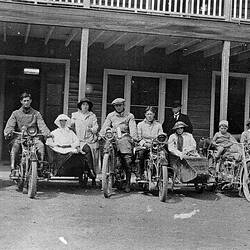Summary
Before becoming an Italian style icon in the 1950s thanks to films such as Roman Holiday, the Vespa (Wasp) was a cheap and practical means of transport introduced in ravaged post-war Italy by the Piaggio Company which had been better known for making aircraft and aircraft engines. The firm was established by Rinaldo Piaggio and originally made railway wagons and ships before branching into aviation during the First World War. The first Vespa was designed by aeronautical engineer Corradino D'Ascanio and production began in 1946 at the Piaggio factory at Pontedera near Genoa. Being cheap and simple to maintain and operate, the Vespa quickly became popular with a range of different engines and models being built up to the present day. The well-known bicycle manufacturer and retailer Malvern Star Ltd acted as the local agent for Vespa motor scooters.
The Museum's Vespa Model GL was built in about 1960 by Douglas (Sales & Service Ltd) in Bristol, England under licence. It is fitted with a 125cc fan-cooled, two-stroke engine. It was donated to the Museum in 1974 by Mr Frank Pitt.
More Information
-
Collection Names
-
Collecting Areas
-
Acquisition Information
Donation from Mr Frank Pitt, Aug 1974
-
Maker
Douglas (Sales & Service) Ltd, Bristol, England, Great Britain, circa 1960
-
Original Source
Mr Frank Pitt, Melbourne, Greater Melbourne, Victoria, Australia, 1974
-
Classification
-
Category
-
Discipline
-
Type of item
-
Overall Dimensions
1770 mm (Length), 670 mm (Width), 980 mm (Height), 80 kg (Weight)
-
Keywords

